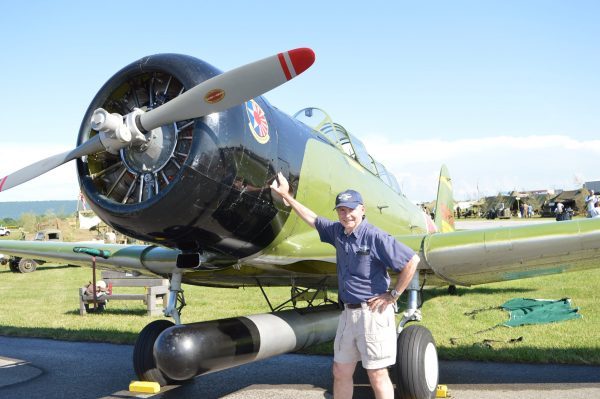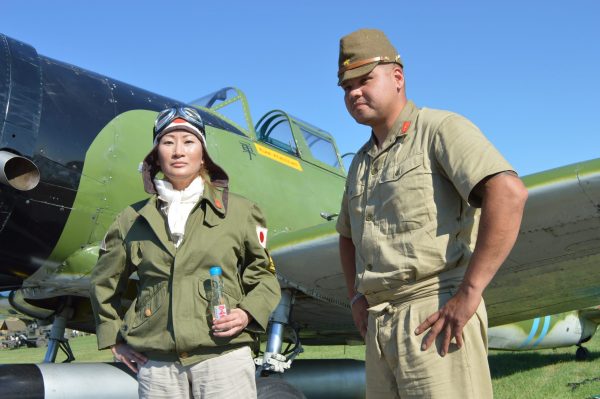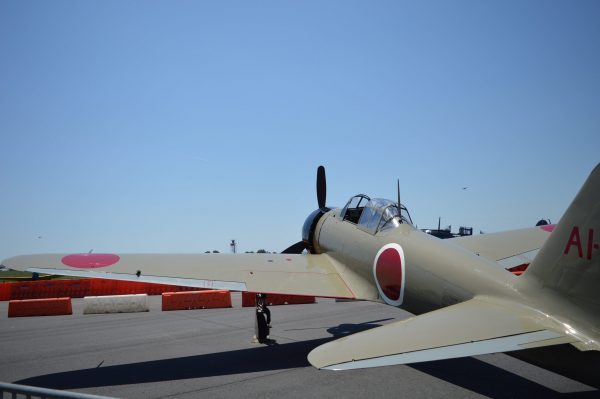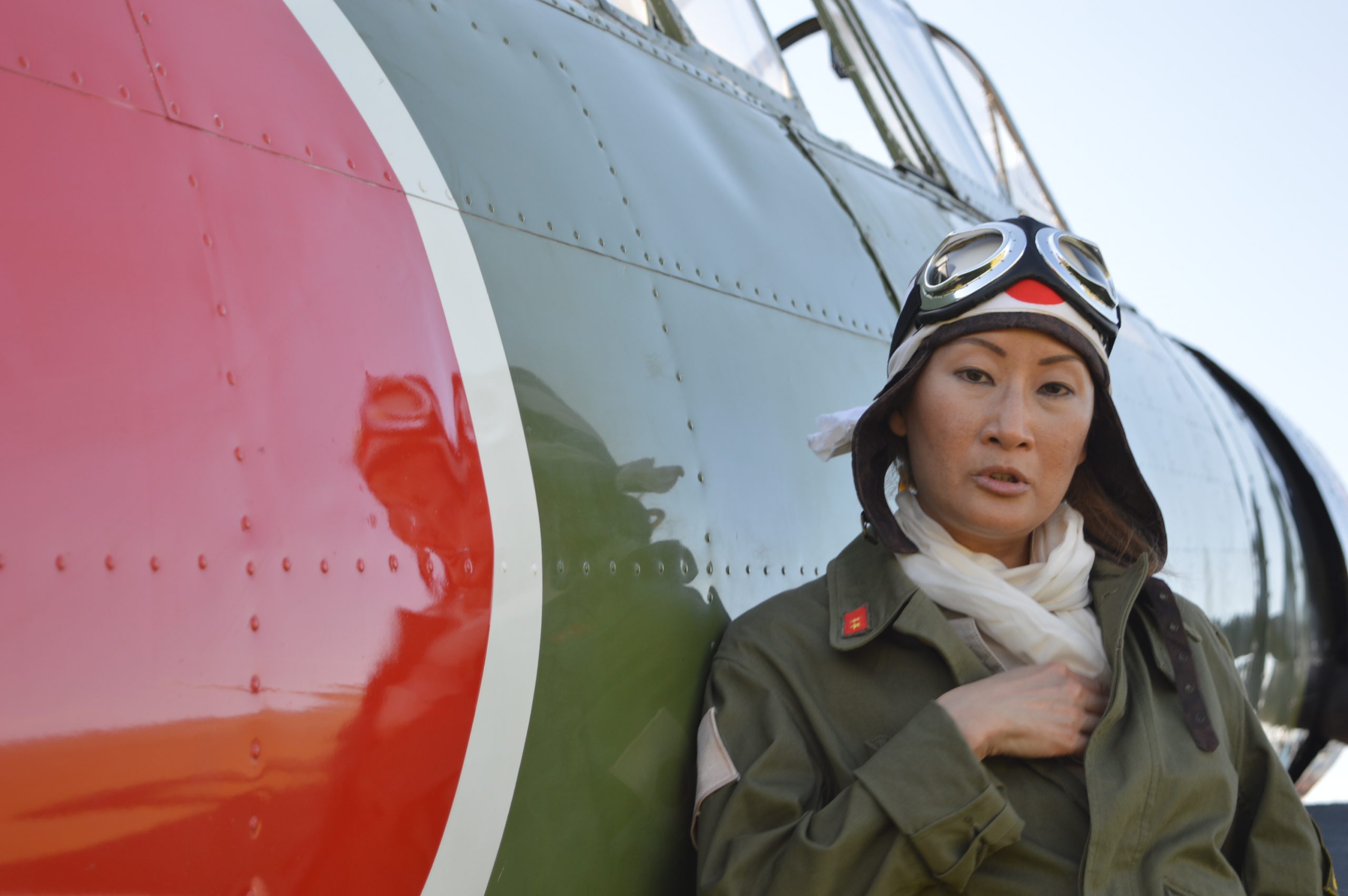World War II Weekend Participants Zero in on ‘The Other Side’
Baltimore Post-Examiner contributing photographer Lady Camille donned the garb of a Japanese pilot to pose beside a replica IJN Nakajima B5N2 “Kate” at the 2021 MAAM WWII Weekend. The show also featured appearances by a Japanese “Val” and a “Zero.” (credit Anthony C. Hayes)
READING, PA — When an event – such as the annual MAAM WWII Weekend – coincides with the D-Day anniversary, it is easy to see how some could guess it’s a European Theater-centered celebration. But walk around the Special Guest hanger at Mid-Atlantic Air Museum and you’ll find a fair share of Pacific Theater veterans recalling action at Midway, Leyte, the Solomon’s Islands, Iwo Jima, Okinawa and Pearl Harbor.
The Pacific Theater is also dramatized with staged land skirmishes between Marine reenactors and their steely adversaries – the Japanese army for these engagements being mustered by a growing contingent of Asian-American reenactors. And there are “bombing runs” and “dogfights” between planes widely associated with the Pacific war: “Corsairs” and “Kates”; “Mustangs” and “Zeros”; “Avengers” and “Vals.”
Alan Armstrong of the Commemorative Air Force (Dixie Wing) is the pilot of one of the “enemy” aircraft – a replica IJN Nakajima B5N2 “Kate”.
“This is a 1943 SNJ North American advanced trainer, built for the US Navy,” explained Armstrong – a pilot with more than 50 years of experience in the air. “It served in World War Two from 1943 to ’45. At the conclusion of war, it was sold as military surplus. It was wrecked at Brown Field in San Diego, California in 1963, then set derelict and broken until 1967, when the motion picture Tora! Tora! Tora! went into pre-production.
“We didn’t have CGI back then, so they had to come up with a way to create a Japanese Air Force. They did that by getting a lot of North Americans and Vultee BT-13s and developing replicas of ‘Zeros’ and ‘Kates’ and ‘Vals.’ The ‘Zero’ is the fighter, the ‘Kate’ the torpedo bomber and high altitude bombers, and the ‘Val’ is the dive bomber.
“That’s why this airplane looks the way it does today.

IJN Nakajima B5N2 “Kate”.
(credit Anthony C. Hayes)
“20th Century Fox paid to have this aircraft extensively modified for the film industry. So it was in Tora! Tora! Tora!; it was in Midway; it was in Baa Baa Black Sheep. It’s been in a bunch of motion pictures and they just have these airplanes around. Today her job is to be the villain in the air shows and to be ‘shot down’ by the Allied fighter planes.
“She does that very nicely. I take off and, a lot of times, I’ll ‘attack’ the airfield, ‘blow things up’, then they’ll dispatch the Allied fighters to intercept me and shoot me down.”
Armstrong said the “Kate” has a smoke system, so it can look like it’s on fire. The flight characteristics, however, differ from the standard model SNJ/T-6 “Texan.”
“She’s a very interesting airplane. She’s pretty large and a lot heavier – not at all like a ‘Texan.’ This airplane’s got a lot of mass to it, so you’ve got to be careful. She doesn’t have quite the horsepower-to-weight ratio you have in the T-6, so she’s not quite as good an in a climb or top-out speed. You know, if you’re not careful on a short final she’ll bite you.”
Does the plane still have the factory power train?
“Yes, but it’s been modified. The fuselage has been lengthened nine feet, and the wingspan lengthened four feet. So it’s a very different airplane than the T-6. She requires some care to fly correctly. She’s just a massive, massive airplane. Even as big as she is, she’s still pretty nimble and fun to fly. She’ll turn and she’s got a good roll and everything. But she requires more respect than the T-6 does.”
Armstrong said two of the real pleasures of flying in the air show circuit with the Commemorative Air Force are “getting a chance to see my buds” and teaching others about the vintage warbirds.
“It’s like going and joining the circus. The people I fly with are a great group of guys. We all speak airplane. Everybody knows what they’re talking about. If you’re a pilot, it’s like going to an advanced flying course because the rigor required to fly these airplanes is much more demanding than flying a normal civilian airplane. These airplanes require a lot of care. So you get your stuff together. You’ve got to know what you’re doing to fly these airplanes,” said Armstrong.

SEEING THE WAR FROM THE OTHER SIDE
Watching the air battles and land skirmishes unfold gives spectators a sense of what the Allied forces faced while fighting the determined Japanese. But as with a tour of the German encampments, there is the history of other side.
David – a businessman from the New York area, who brought two teens with him to the MAAM WWIII Weekend – has long been fascinated by the war in the Pacific.
Some of David’s relatives worked on the home front to support the war effort. One of his uncles even flew fighter planes in the navy. What makes his story unique is David is Japanese-American, and members of his family fought and worked for the Empire of Japan during the war.
“My interest in historical reenactment comes from the experiences of my mother’s family, who were actually living in war-time Japan. I am a Sansei, a Third Generation Japanese-American, born in the United States. But my relatives were all in Japan during the war. My uncle was actually a ‘Zero’ pilot. He was flying in Japan, for the Imperial Japanese Navy during WWII. After the war, he lived in Los Angeles. That’s where I grew up. We heard a lot of stories about planes and flying the ‘Zeros’ and what have you from him.
“So we have an affinity for that history.
“For me, growing up, it was just like when you hear your grandfather talking about that time. ‘Well, what I did in WWII…’ and so on.
“But it’s a different side of the story.
“And my mother, who was living in Japan from just before the war and all throughout the war, was a young teen-aged girl. She, like everyone else in high school, was working in a munitions factory, helping to assemble planes. You might say she was the Japanese equivalent of a Rosie the Riveter, and was a part of their war effort.”

(credit Anthony C. Hayes)
David’s visit to MAAM, along with his son and son’s best friend, were strongly encouraged by BPE contributing photographer Lady Camille. Camille had caught word that David owned a Japanese uniform and thought, ‘What better place to show it than at the World War II Weekend?’
“I got the uniform about 25 years ago at a surplus store in Tokyo,” said David. “This store supplied a lot of different surplus items and what have you for U.S. military personnel. But they were also suppliers of equipment and reenactment gear for movies. I went there with the intention of buying a jacket, and putting all the correct patches on it, just have as a keepsake or show visitors who came to my home. Camille found out about it and suggested I bring it to the show. But I said, ‘Why don’t you just borrow my jacket and you can wear that at the event.’ So that’s how it is that she is wearing the uniform today.
“We have been posing for pictures and answering questions about that side of the war. Everyone we have met here has been very open and friendly. My son is already texting his other friends about what he is seeing and they all want to come here next year.”
Being unfamiliar with the assorted insignia of the Japanese uniform, we asked David for a quick tutorial.
“This jacket style is an Imperial Japanese Army Air Force. It’s a little bit of a mix, really a tropical uniform, but it’s actually from around 1943/1944. By late ‘45, uniforms got a little bit lighter because supplies and material was getting rare. The stars indicate it’s for a private first class, and the flags are the national flag of Japan. Army uniforms do not have the emblem with the rising sun because that was for the Navy. This particular patch is clearly for the army.
“The other arm patch that we have is called Kikusui, which means ‘chrysanthemum over water.’ It’s indicative of the Kamikaze Special Attack Forces. So theoretically, this jacket is something that a pilot would have worn while defending Japan’s homeland.
“The helmet is a summer weight design. It’s not vintage, but it looks really close. The same with the goggles. The Japanese did not wear sunglasses too often, so the glass in the goggles was mostly clear. The headband says ‘Assured Victory.’ The symbol of victory for this one is a copy of the same headband that they gave to Lt. Commander Mitsuo Fuchida on the decks of the carrier Akagi to lead the attack on Pearl Harbor.
“It’s got a lot of fidelity to the design, so one can say it’s an accurate copy of an original.
“Is all of this of interest to your readers?,” asked David.
I nodded “yes.”
“Could be a little different,” he concluded, “but yes, I think so, too.”

© Copyright 2021 Baltimore Post-Examiner. All Rights Reserved

Anthony C. Hayes is an actor, author, raconteur, rapscallion and bon vivant. A one-time newsboy for the Evening Sun and professional presence at the Washington Herald, Tony’s poetry, photography, humor, and prose have also been featured in Smile, Hon, You’re in Baltimore!, Destination Maryland, Magic Octopus Magazine, Los Angeles Post-Examiner, Voice of Baltimore, SmartCEO, Alvarez Fiction, and Tales of Blood and Roses. If you notice that his work has been purloined, please let him know. As the Good Book says, “Thou shalt not steal.”

